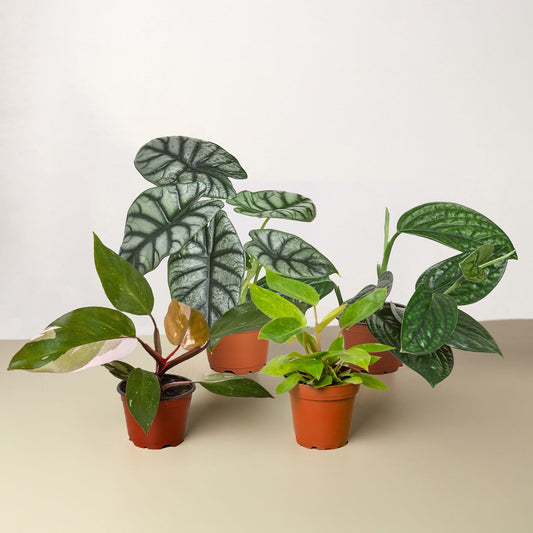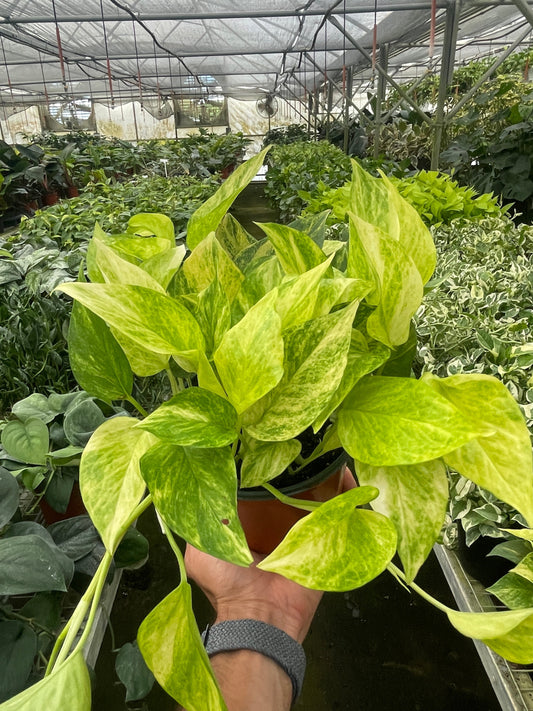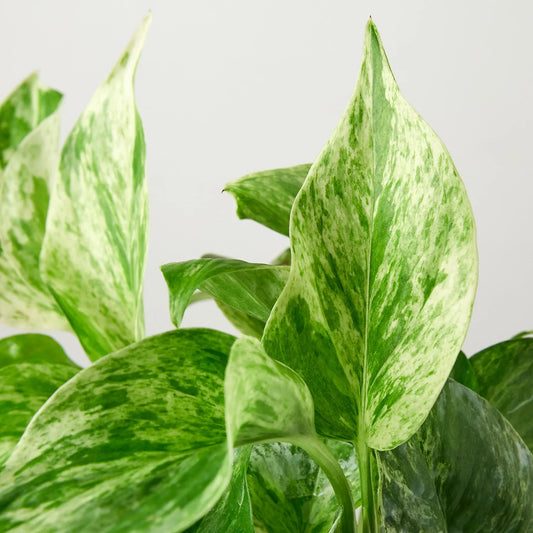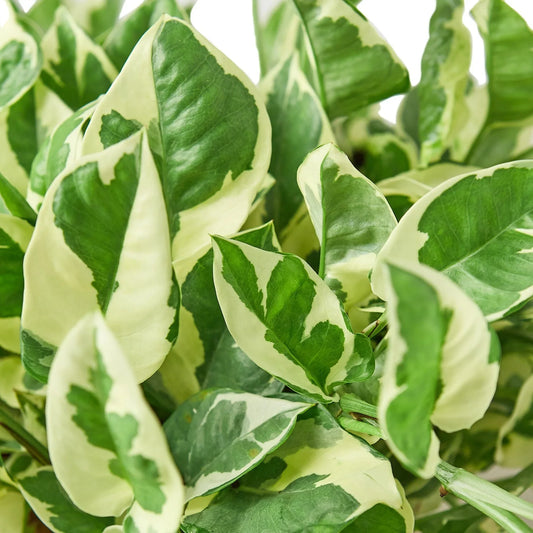How Much Humidity Does My Golden Pothos Need?
Cafe Planta Team
If you’ve ever owned a Golden Pothos, you’ll know how forgiving and easygoing this popular houseplant can be. But, like any living thing, it does have its preferences. Among those is its fondness for a certain level of humidity. Too dry, and you might notice those charming heart-shaped leaves starting to look a little less lively. Too wet, and you might be dealing with a whole different set of issues.
In this article, we’ll explore just how much humidity your Golden Pothos really needs to thrive. We’ll cover everything from ideal humidity levels and signs your plant might be struggling, to tips and tricks for creating the perfect environment. Whether you’re a seasoned plant parent or just starting your green journey, there’s something here for you.
Understanding Golden Pothos and Its Natural Habitat
Before diving into the specifics of humidity, it’s helpful to understand where Golden Pothos, also known as Epipremnum aureum, comes from. This plant is native to the Solomon Islands, a group of islands in the tropical Pacific Ocean. Imagine a lush, tropical forest with high humidity and dappled sunlight filtering through the canopy. That’s where Pothos naturally thrives.
This tropical background explains why Pothos love environments that mimic their native habitat. In the wild, they climb trees and sprawl across the forest floor, soaking up the moisture from the humid air. So, while they can survive in less-than-ideal conditions, they really hit their stride when the humidity is just right.
Understanding this natural setting can help us replicate similar conditions at home. It’s all about creating the right balance of moisture and light, which often means thinking beyond simply watering your plant. Humidity plays a crucial role in keeping those leaves glossy and vibrant.
What Humidity Levels Do Golden Pothos Prefer?
Golden Pothos are quite adaptable, which is one reason they’re a favorite among plant lovers. However, when it comes to humidity, they do have a sweet spot. Ideally, these plants prefer humidity levels between 50% and 70%. This range replicates their natural tropical environment, helping them grow healthy and strong.
In homes, especially during winter, humidity levels can drop significantly, sometimes falling below 30%. This can be tough on Pothos and other tropical plants. When the air is too dry, you might notice the edges of the leaves turning brown and crispy, or the plant might generally look a little stressed.
On the flip side, while Pothos can handle higher humidity levels, it’s important not to go overboard. Very high humidity, especially without good air circulation, can lead to problems like mold or fungal infections. So, while you don’t need to turn your home into a rainforest, a little extra moisture in the air can make a big difference.
Signs Your Pothos Needs More Humidity
Plants are pretty good at communicating their needs, even if it’s not in words. Your Golden Pothos will give you some clear signals if it’s craving more humidity. Here’s what to watch out for:
- Brown Leaf Tips: One of the most common signs of low humidity is browning at the tips of the leaves. This is a sign that the plant is losing moisture faster than it can replace it.
- Wilting Leaves: If the leaves start to droop or look limp, it could be a sign that the air is too dry, and the plant is struggling to retain moisture.
- Slow Growth: While Pothos are not the fastest growers, they should still show some growth during their active seasons. If you notice a lack of new leaves or stems, it could be related to insufficient humidity.
Keeping an eye on your plant’s physical appearance and growth can help you make adjustments to its care routine. Just a little extra attention to environmental conditions can prevent these issues from cropping up.
How to Increase Humidity for Your Pothos
If you notice any of the signs mentioned above, don’t worry. There are several easy ways to boost the humidity around your Golden Pothos, helping it flourish. Here are some practical tips:
- Group Your Plants: Placing your plants close together can create a microclimate with higher humidity. As plants transpire, they release moisture into the air, benefiting each other.
- Use a Humidifier: A humidifier is an effective way to control humidity levels, especially during dry months. Position it near your plants to ensure they’re getting enough moisture.
- Mist Your Plants: Lightly misting your Pothos with water can temporarily increase humidity. Just be sure not to overdo it, as too much moisture on the leaves can lead to mold.
- Place a Pebble Tray: Fill a tray with pebbles and add water until just below the top of the stones. Place your Pothos pot on the tray. As the water evaporates, it increases the humidity around the plant.
These methods can be combined for even better results. Experiment with different techniques to see what works best for your home environment and your plant.
Maintaining the Right Balance
While increasing humidity can be beneficial, it’s important to maintain a balance. Too much humidity with poor air circulation can cause problems like mold or root rot. Here are some tips to avoid these issues:
- Ensure Good Air Circulation: Make sure there’s good airflow around your plants. Use fans if necessary to keep the air moving and prevent stagnation.
- Avoid Overwatering: High humidity can mean the soil stays moist longer. Be careful not to water your Pothos too frequently, as soggy soil can lead to root problems.
- Watch for Mold: Keep an eye out for any mold or mildew on the soil or leaves. If you spot any, reduce humidity levels and improve air circulation.
Finding the right balance may take a bit of trial and error, but once you get it right, your Pothos will thrive.
Using Technology to Monitor Humidity
In today’s tech-savvy world, there are plenty of gadgets and apps that can help you keep track of humidity levels in your home. Here’s how technology can be your friend:
- Humidity Meters: Also known as hygrometers, these devices measure the humidity level in your home. They’re an affordable and easy way to keep tabs on the environment.
- Smart Home Devices: Some smart home systems can monitor and adjust humidity levels automatically, providing consistent conditions for your plants.
- Plant Care Apps: There are apps designed to help you track plant care, including humidity needs. These can be a great resource for reminders and tips.
Using technology can take some of the guesswork out of maintaining the perfect environment for your Pothos, making it easier to ensure your plant’s needs are consistently met.
The Role of Temperature in Humidity
Temperature and humidity are closely linked. Higher temperatures can cause humidity levels to drop, as warm air holds more moisture. Here’s how temperature can affect your Pothos:
- Warm Environments: If your home tends to be warm, consider using a humidifier or misting your plants more frequently to maintain the right humidity level.
- Cold Weather: During colder months, heating systems can dry out the air. This is when your Pothos might need extra humidity support.
- Avoid Temperature Extremes: Pothos prefer steady temperatures. Avoid placing them near heat sources or cold drafts that can stress the plant.
By keeping an eye on both temperature and humidity, you can create a more comfortable environment for your plant, leading to happier and healthier growth.
Common Mistakes to Avoid
It’s easy to make mistakes when caring for houseplants, especially when it comes to humidity. Here are some common pitfalls and how to avoid them:
- Over-Misting: While misting can increase humidity, overdoing it can lead to fungal issues. Mist lightly and infrequently.
- Ignoring Air Circulation: Stagnant air can cause problems, even with the right humidity. Ensure good airflow around your plants.
- Neglecting Seasonal Changes: Humidity needs can change with the seasons. Be prepared to adjust your care routine as the weather shifts.
By avoiding these common mistakes, you’ll be well on your way to maintaining a healthy environment for your Golden Pothos.
Final Thoughts
Ensuring your Golden Pothos has the right humidity is key to keeping it healthy and vibrant. By paying attention to its natural preferences and adjusting your home environment accordingly, you can enjoy this beautiful plant for years to come.
At Cafe Planta, we’re passionate about helping you care for your plants. Whether you’re looking for new houseplants, care accessories, or just some plant-themed gear, we’ve got you covered. If you have any questions, feel free to email us or send a message on Instagram. We believe plants bring people together, and we’re excited to help you create a thriving plant collection in your home.



















